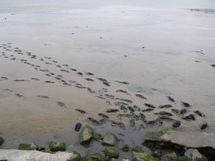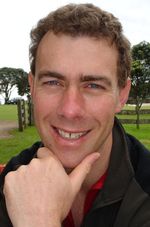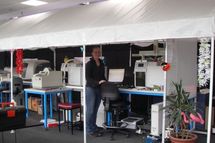Our Changing World for Thursday 13 December 2012
Earthquake Effects on Heathcote-Avon Estuary
 For many years Christchurch’s treated sewage was put directly into the Heathcote-Avon Estuary, until in March 2010 a 3-kilometre long ocean outfall diverted the wastewater out to sea. David Schiel from the University of Canterbury and John Zeldis from NIWA were investigating the effects of the diversion on the ecology and health of the very eutrophic Heathcote-Avon Estuary when the Christchurch earthquakes happened, re-engineering both the estuary and their experiments. The southern half of the estuary was uplifted by half a metre while the northern half sank by half a metre, there was significant liquefaction across much of the estuary, and 7 billion litres of raw sewage flowed into the estuary before the city’s reticulation system was fixed.
For many years Christchurch’s treated sewage was put directly into the Heathcote-Avon Estuary, until in March 2010 a 3-kilometre long ocean outfall diverted the wastewater out to sea. David Schiel from the University of Canterbury and John Zeldis from NIWA were investigating the effects of the diversion on the ecology and health of the very eutrophic Heathcote-Avon Estuary when the Christchurch earthquakes happened, re-engineering both the estuary and their experiments. The southern half of the estuary was uplifted by half a metre while the northern half sank by half a metre, there was significant liquefaction across much of the estuary, and 7 billion litres of raw sewage flowed into the estuary before the city’s reticulation system was fixed.
Alison Ballance catches up with David and John, as well as technician Paul South and PhD students Jen Skilton and Kristin Scheuer to find out what happened and what state the estuary is in now. They meet at what had been one of the worst polluted sites in the estuary, but which no longer has the deep mats of rotting macroalgae (pictured above). NIWA has prepared reports for the Christchurch City Council on impacts on macroalgae (PDF) such as sea lettuce and also on the biota (PDF).
David and John’s project ‘After the outfall’ featured in a previous Our Changing World story in March 2010, at the time of the wastewater diversion.
Sympathetic Nervous System
 Simon Malpas (left) is a principal investigator at the University of Auckland’s Circulatory Control Laboratory where he looks at the control of blood pressure, and in particular the mechanisms responsible for the development of hypertension and other cardiovascular diseases.
Simon Malpas (left) is a principal investigator at the University of Auckland’s Circulatory Control Laboratory where he looks at the control of blood pressure, and in particular the mechanisms responsible for the development of hypertension and other cardiovascular diseases.
Ruth Beran went on a tour of the lab, and saw the unique wireless monitoring equipment developed at the University of Auckland used to monitor a number of cardiovascular variables such as blood pressure, sympathetic nerve activity, heart rate and blood flow for extended periods of time.
In particular, the telemetry-based equipment is being used to record sympathetic activity to the kidney during the development of hypertension. New information has emerged to indicate that sympathetic nerves are a key controller of the cardiovascular system in a variety of situations. While increases in sympathetic nerve activity may be important in the development of hypertension, little is known about how or why this translates to increased blood pressure.
Ultimately, Simon would like to gain an entirely new understanding of the development of hypertension over time in order to better treat humans.
Genetic Map of First New Zealanders

Michael Knapp working on samples of ancient DNA in a laboratory designed and built especially for this purpose to avoid contamination (images: M Knapp)
Wairau Bar in Marlborough is one of the most significant archaeological sites in New Zealand. More than 700 years ago, there was a settlement whose residents were among the first people to have stepped ashore in Aotearoa.
Archaeological excavations began in the late 1930s and the material collected from the site, most of which is now part of the collections at Canterbury Museum, provided the first conclusive evidence that New Zealand was originally settled from East Polynesia. Apart from artefacts, archaeologists also removed human remains from 44 graves for further investigations. The remains were reburied three years ago as the tangata whenua, Rangitane iwi, sought to have the koiwi tangata of their tupuna returned to their land.
A team of researchers at the University of Otago, including archaeologist Richard Walter, biological anthropologists Lisa Matisoo-Smith and Hallie Buckley and evolutionary biologist Michael Knapp, studied the skeletal remains and discovered a wealth of information about the diet and health of these pioneering navigators who became New Zealand’s first settlers.
With the permission of Rangitane iwi, the remains were also screened for DNA preservation in a study led by Lisa Matisoo-Smith. Of the 19 burials examined, four provided samples of ancient DNA that was preserved well enough to allow amplification and sequencing. In this interview, Michael Knapp explains how the team was able to sequence the complete mitochondrial genomes (which is inherited only through the mother's side) and found a surprising degree of genetic variation. They also found that all four people shared a unique genetic markers found in modern Maori and that one of the settlers carried a genetic mutation linked with insulin resistance, which leads to type 2 diabetes.
This latest study was published here (pdf).
Breath Research Group and Infectious Diseases
 Steve Chambers and Amy Scott-Thomas from the Breath Research Group at the University of Otago, Christchurch tell Alison Ballance how they hope to use ‘breath’ as a non-invasive diagnostic tool for infectious diseases such as TB. Steve Chambers is an infectious disease physician for the Canterbury District Health Board, and he explains that it is difficult to get sputum samples from deep within the lung, so he had the idea of using breath as a diagnostic tool, as it is easily collected. Amy has been identifying aromatic compounds that are specific to infectious disease agents such as Aspergillus and Pseudomonas, and determining if they exist in sufficient quantities in breath to be analysed. Work has carried on in the last 2 years despite the disruption caused by the earthquakes in Christchurch - for the last few months Amy's lab has been located under a garden gazebo in what used to be the Christchurch Hospital cafe. The gazebo is to stop leaks reaching her equipment (pictured above right).
Steve Chambers and Amy Scott-Thomas from the Breath Research Group at the University of Otago, Christchurch tell Alison Ballance how they hope to use ‘breath’ as a non-invasive diagnostic tool for infectious diseases such as TB. Steve Chambers is an infectious disease physician for the Canterbury District Health Board, and he explains that it is difficult to get sputum samples from deep within the lung, so he had the idea of using breath as a diagnostic tool, as it is easily collected. Amy has been identifying aromatic compounds that are specific to infectious disease agents such as Aspergillus and Pseudomonas, and determining if they exist in sufficient quantities in breath to be analysed. Work has carried on in the last 2 years despite the disruption caused by the earthquakes in Christchurch - for the last few months Amy's lab has been located under a garden gazebo in what used to be the Christchurch Hospital cafe. The gazebo is to stop leaks reaching her equipment (pictured above right).
Previous research had showed that trained Gambian rats would identify compounds produced by TB, and Max Suckling from Plant and Food Research explains how honeybees could also be trained to detect diagnostic aromatic compounds in the breath samples, as they are the same volatile compounds produced by flowers. This work has been developed as a proof of principle but has not yet been used with clinical samples from patients.